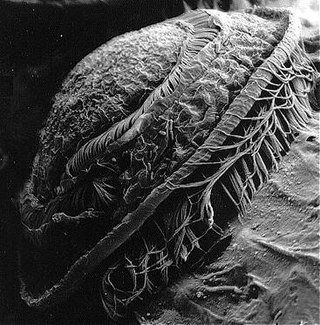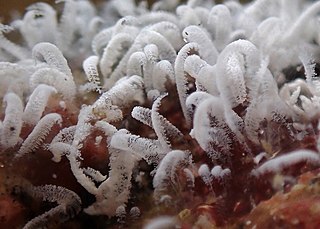
The alveolates are a group of protists, considered a major clade and superphylum within Eukarya. They are currently grouped with the stramenopiles and Rhizaria among the protists with tubulocristate mitochondria into the SAR supergroup.
The plagiopylids are a small order of ciliates, including a few forms common in anaerobic habitats.

The Oligohymenophorea are a large class of ciliates. There is typically a ventral groove containing the mouth and distinct oral cilia, separate from those of the body. These include a paroral membrane to the right of the mouth and membranelles, usually three in number, to its left. The cytopharynx is inconspicuous and never forms the complex cyrtos found in similar classes. Body cilia generally arise from monokinetids, with dikinetids occurring in limited distribution over part of the body.

The hymenostomes are an order of ciliate protozoa. Most are free-living in freshwater, such as the commonly studied genus Tetrahymena, but some are parasitic on fish or aquatic invertebrates. Among these is the important species Ichthyophthirius multifiliis, a common cause of death in aquaria and fish farms.

The Colpodea are a class of ciliates, of about 200 species common in freshwater and soil habitats. The body cilia are typically uniform, and are supported by dikinetids of characteristic structure, with cilia on both kinetosomes. The mouth may be apical or ventral, with more or less prominent associated polykinetids. Many are asymmetrical, the cells twisting sideways and then untwisting again prior to division, which often takes place within cysts. Colpoda, a kidney-shaped ciliate common in organic rich conditions, is representative.

Balantidium is a genus of ciliates. It contains the parasitic species Balantidium coli, the only known cause of balantidiasis.

Cryptocaryon irritans is a species of ciliates that parasitizes marine fish, causing marine white spot disease or marine ich. It is one of the most common causes of disease in marine aquaria.
Karyorelictea is a class of ciliates in the subphylum Postciliodesmatophora. Most species are members of the microbenthos community, that is, microscopic organisms found in the marine interstitial habitat, though one genus, Loxodes, is found in freshwater.

The ciliates are a group of alveolates characterized by the presence of hair-like organelles called cilia, which are identical in structure to eukaryotic flagella, but are in general shorter and present in much larger numbers, with a different undulating pattern than flagella. Cilia occur in all members of the group and are variously used in swimming, crawling, attachment, feeding, and sensation.

Euplotes is a genus of ciliates in the subclass Euplotia. Species are widely distributed in marine and freshwater environments, as well as soil and moss. Most members of the genus are free-living, but two species have been recorded as commensal organisms in the digestive tracts of sea urchins.
Orchitophrya stellarum is a species of single-celled marine ciliates, a member of the class Oligohymenophorea. It is found living freely in the north Atlantic and Pacific Oceans but is also parasitic, being found inside the gonads of starfish.

Trichodinidae is a family of ciliates of the order Mobilida, class Oligohymenophorea. Members of the family are ectoparasites of a wide variety of aquatic organisms, including fish, amphibians, hydrozoans, molluscs and crustaceans.

Mobilida is a group of parasitic or symbiotic peritrich ciliates, comprising more than 280 species. Mobilids live on or within a wide variety of aquatic organisms, including fish, amphibians, molluscs, cnidarians, flatworms and other ciliates, attaching to their host organism by means of an aboral adhesive disk. Some mobilid species are pathogens of wild or farmed fish, causing severe and economically damaging diseases such as trichodinosis.

Chromidina is a genus of apostome ciliates of the family Opalinopsidae. Species of Chromidina are parasitic in the renal and pancreatic appendages of cephalopods.

Armophorea is a class of ciliates in the subphylum Intramacronucleata. . It was first resolved in 2004 and comprises three orders: Metopida, Clevelandellida, and Armophorida. Previously members of this class were thought to be heterotrichs because of similarities in morphology, most notably a characteristic dense arrangement of cilia surrounding their oral structures. However, the development of genetic tools and subsequent incorporation of DNA sequence information has led to major revisions in the evolutionary relationships of many protists, including ciliates. Metopids, clevelandellids, and armophorids were grouped into this class based on similarities in their small subunit rRNA sequences, making them one of two so-called "riboclasses" of ciliates, however, recent analyses suggest that Armophorida may not be related to the other two orders.
Miamiensis avidus is a species of unicellular marine eukaryote that is a parasite of many different types of fish. It is one of several organisms known to cause the fish disease scuticociliatosis and is considered an economically significant pathogen of farmed fish. M. avidus is believed to be the cause of a 2017 die-off of fish and sharks in the San Francisco Bay.

Philasterides dicentrarchi is a marine protozoan ciliate that was first identified in 1995 after being isolated from infected European sea bass reared in France. The species was also identified as the causative agent of outbreaks of scuticociliatosis that occurred between summer 1999 and spring 2000 in turbot cultivated in the Atlantic Ocean. Infections caused by P. dicentrarchi have since been observed in turbot reared in both open flow and recirculating production systems. In addition, the ciliate has also been reported to cause infections in other flatfishes, such as the olive flounder in Korea and the fine flounder in Peru, as well as in seadragons, seahorses, and several species of sharks in other parts of the world.
Scuticociliatosis is a severe and often fatal parasitic infection of several groups of marine organisms. Species known to be susceptible include a broad range of teleosts, seahorses, sharks, and some crustaceans. The disease can be caused by any one of about 20 distinct species of unicellular eukaryotes known as scuticociliates, which are free-living marine microorganisms that are opportunistic or facultative parasites. Scuticociliatosis has been described in the wild, in captive animals in aquariums, and in aquaculture. It is best studied in fish species that are commonly farmed, in which typical effects of infection include skin ulceration, hemorrhage, and necrosis, with post-mortem examination identifying ciliates in the skin, gills, blood, and internal organs including the brain.

Zoothamnium is a genus of ciliate protozoan.
Philasteridae is a family of ciliates in the order Philasterida.











